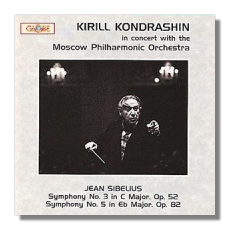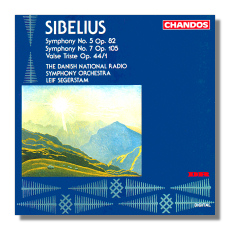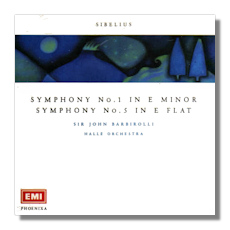
The Internet's Premier Classical Music Source
Related Links
- Sibelius Reviews
- Latest Reviews
- More Reviews
-
By Composer
-
Collections
DVD & Blu-ray
Books
Concert Reviews
Articles/Interviews
Software
Audio
Search Amazon
Recommended Links
Site News
 CD Review
CD Review
Jean Sibelius

Symphonies
- Symphony 5 in E Flat Major, Op. 82 (1919)
- Symphony 3 in C Major, Op. 52 (1907)
Moscow Philharmonic Orchestra/Kirill Kondrashin
Globe 6011 52min


- Symphony 5 in E Flat Major, Op. 82 (1919)
- Symphony 7 in C Major, Op. 105 (1924)
- Valse Triste
Danish National Radio Symphony Orchestra/Leif Segerstam
Chandos CHAN9055 - 64min


- Symphony 5 in E Flat Major, Op. 82 (1919)
- Symphony 1 in E minor, Op. 39 (1899)
Hallé Orchestra/John Barbirolli
EMI CDM7-64139-2 - 74min
The Kondrashin, alas, may be disposed of quickly. While these two performances were given over three years apart (in 1973 & 1977), they might well have been recorded at the same concert. Both suffer from the same defects. The symphonies move at a frenetic pace, allowing little room for feeling, expression or character. For example, compare Kondrashin's timings with Barbirolli's in Symphony 5:
| I | II | III | |
| Kondrashin | 12:16 | 6:47 | 7:18 |
| Barbirolli | 14:19 | 9:19 | 9:49 |
Kondrashin's distant and uninvolved reading begins only slightly faster than the norm, but roughly shifts into high gear at the allegro moderato (7:22). II is rushed and utterly charmless, while III hurries by without nobility or passion. At these breakneck tempos, the composer's superb wind and string writing often cannot be articulated cleanly. The playing is tense and nervous, punctuated by harsh, unpleasantly razor-sharp accents. Symphony 3 starts in a more promising fashion, but begins to feel rushed by the time we reach the development section of I. From there to the end, it's more of the same.
The sound of these analog concert tapes is hissy, but not obtrusively so. However, the hacking and program rustling of the restless audiences soon becomes irritating. Surely Globe (and the conductor's son Pyotr, from whose private collection these tapes derive) could have produced a more fitting memorial to this brilliant Russian conductor.
Of the recordings under consideration here, Chandos offers the most natural, warm, and atmospheric sound. The Danish Orchestra plays exceptionally well for their chief conductor, Segerstam. Note especially the rich tone of the string ensemble in II of Symphony 5 and the opening of Symphony 7.
The slow movement of the Fifth is the highlight of this disc (along with a sensuous reading of the Valse Triste). In II, Segerstam's tempos are right on the money, and his interpretation dances effortlessly from start to finish. This music's subtext of isolation and despair (so perfectly captured in Bernstein's Vienna recording on DG) is not Segerstam's cup of tea. Thus he downplays the searing dissonances in the winds. In contrast, I comes across as utterly earthbound. The tempo changes indicated in the score – accelerating imperceptibly from the opening molto moderato to the presto of the final page – are abrupt and heavy-handed. The timpani are overly prominent, especially at the end of I, where the score's powerful, surging strings are completely lost in a blur of brass and timpani.
Segerstam's interpretation of Symphony 7 has much to recommend it. The orchestral playing is even more beautiful than in Symphony 5. The slower sections of the work are given a lyrical and dramatic treatment that is often quite intense. Still, the faster music – especially in the scherzo, beginning at 9:50 – often lacks the flaming intensity, sweep, and sheer playfulness that Serge Koussevitzky's BBC Symphony recording revealed.Nor does Segerstam have the organic unity that made Koussevitzky's approach so gripping. But then again, no one has approached him in the six decades since his unforgettable performance was etched into wax.
Like Koussevitzky, Sir John Barbirolli was among the most persuasive Sibelius interpreters. Barbirolli's recordings of Symphonies 1 and 5 date from the dawn of the stereo era. Both were originally made for Pye in 1957, during the year of the composer's death.
From the very first notes in the horns and timpani, it is clear that this recording of Symphony 5 is unique. Barbirolli was a supreme dramatist, and his Fifth is riveting from start to finish. The heroic first movement has rarely been more brilliant or exciting. Each subtle tempo change is perfectly judged and executed. The Hallé strings achieve a beautiful, searing tone, while the wind playing is sweet and elegant. Only the final page of I – where the timpani are allowed to overwhelm both the strings and the brass – mars an otherwise breathtaking experience. Barbirolli maintains a fine balance between the dance music in the strings and the poignant dissonances of the winds in II, while in III he achieves a reverent nobility that must have brought down the house in Manchester.
As good as the Barbirolli Fifth certainly is, the First is finer still. The instrumental effects that this conductor and his orchestra produce are stunning – especially the muted strings at the beginning of II, which sound uncannily like a wordless choir. Barbirolli's interpretation thrives on extreme contrasts of tempo, mood, and dynamics. The result is both emotionally charged and enchanting, as though a master story-teller were relating an epic tale (perhaps from the Kalevala) using every one of the expressive devices at his command. While I have not heard the later Barbirolli recording of this work (John McKelvey called it "the finest performance of the First Symphony now available" in the S/O 1989 issue), I can say that comparisons are simply out of the question here. This interpretation is without peer.
My only reservation about this disc is EMI's claustrophobic sound. In the First Symphony, the violins come across as wiry, and the instrumental solos (especially the harp in I) are unnaturally close-up. While ensemble balances in Symphony 5 are much more realistic, there is little high frequency information. The result sounds like an AM radio broadcast, and the conclusion of I becomes a distorted jumble. That caveat aside, if you want to hear some of the best Sibelius ever put on disc, you can't go wrong with this Barbirolli issue.
Copyright © 1995, Thomas Godell.
This review originally appeared in the American Record Guide


















